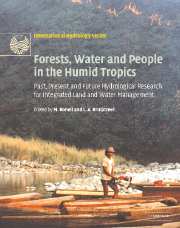 Forests, Water and People in the Humid Tropics
Forests, Water and People in the Humid Tropics Book contents
- Frontmatter
- Contents
- List of contributors
- Foreword
- Preface
- Acknowledgements
- Symposium and Workshop
- Introduction
- Part I Current trends and perspectives on people–land use–water issues
- Part II Hydrological processes in undisturbed forests
- Part III Forest disturbance, conversion and recovery
- Part IV New methods for evaluating effects of land-use change
- 27 Remote sensing tools in tropical forest hydrology: new sensors
- 28 Detecting change in river flow series
- 29 How to choose an appropriate catchment model
- 30 The disaggregation of monthly streamflow for ungauged sub-catchments of a gauged irrigated catchment in northern Thailand
- 31 Parsimonious spatial representation of tropical soils within dynamic rainfall—runoff models
- 32 Isotope tracers in catchment hydrology in the humid tropics
- 33 Process-based erosion modelling: promises and progress
- 34 Impacts of forest conversion on the ecology of streams in the humid tropics
- Part V Critical appraisals of best management practices
- Conclusion: Forests, water and people in the humid tropics: an emerging view
- Plate section
- References
30 - The disaggregation of monthly streamflow for ungauged sub-catchments of a gauged irrigated catchment in northern Thailand
from Part IV - New methods for evaluating effects of land-use change
Published online by Cambridge University Press: 12 January 2010
- Frontmatter
- Contents
- List of contributors
- Foreword
- Preface
- Acknowledgements
- Symposium and Workshop
- Introduction
- Part I Current trends and perspectives on people–land use–water issues
- Part II Hydrological processes in undisturbed forests
- Part III Forest disturbance, conversion and recovery
- Part IV New methods for evaluating effects of land-use change
- 27 Remote sensing tools in tropical forest hydrology: new sensors
- 28 Detecting change in river flow series
- 29 How to choose an appropriate catchment model
- 30 The disaggregation of monthly streamflow for ungauged sub-catchments of a gauged irrigated catchment in northern Thailand
- 31 Parsimonious spatial representation of tropical soils within dynamic rainfall—runoff models
- 32 Isotope tracers in catchment hydrology in the humid tropics
- 33 Process-based erosion modelling: promises and progress
- 34 Impacts of forest conversion on the ecology of streams in the humid tropics
- Part V Critical appraisals of best management practices
- Conclusion: Forests, water and people in the humid tropics: an emerging view
- Plate section
- References
Summary
INTRODUCTION
Background
Accurate water resource assessment in northern Thailand is of crucial importance for sustainable agricultural development as well as for resolving upland-downstream conflicts related to allegedly excessive water use by highland rural communities. Fair water resource allocation is especially important during the dry season because in regions with a monsoon climate, such as Northern Thailand, the availability of water for irrigation during that season offers a prospect of growing a second crop in one year.
The major problem for accurate streamflow modelling in Thailand as well as in many developing countries is that catchments are often poorly instrumented. For instance, the Mae Chaem catchment at Kong Kan (2157 km2) has only three gauging stations: at Kong Kan (Station number 04061302), the 1180 km2 catchment of the Mae Chaem River at Huai Phung (04061201) and the 68.5 km2 Mae Mu River subcatchment at Ban Mae Mu (04061202). A map of the Mae Chaem basin, showing the subcatchments under consideration and gauging station locations is presented in Figure 30.1.
Climate and physiography
Thailand, including the Mae Chaem catchment of the Ping Basin in its northern part, has a monsoonal climate. The climate is characterised by a wet period from the end of May to September and a very dry period in the remainder of the year. In some years no rain falls for three months or more.
- Type
- Chapter
- Information
- Forests, Water and People in the Humid TropicsPast, Present and Future Hydrological Research for Integrated Land and Water Management, pp. 742 - 755Publisher: Cambridge University PressPrint publication year: 2005


